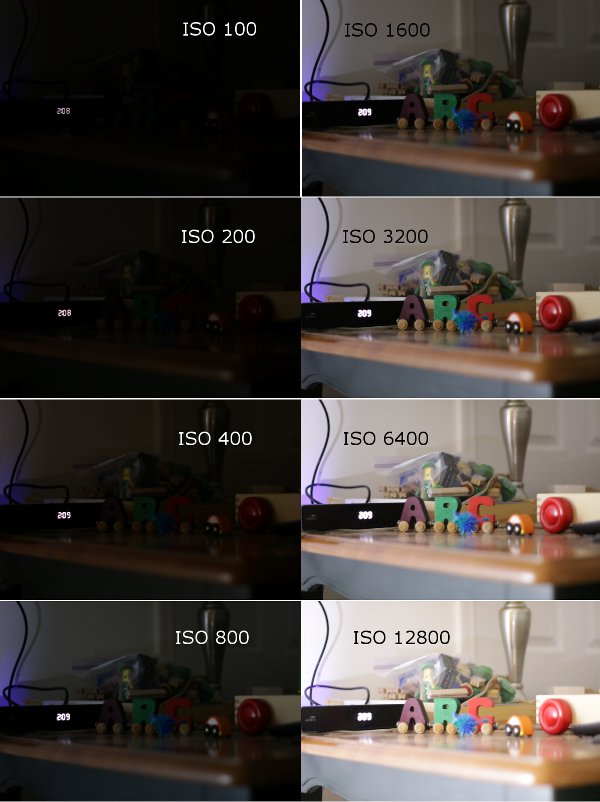It's a grey, dismal, rainy day here at Chateau Steelypips, and I'm a little groggy from cold medication. Which means it's not a great writing day, but it is a good day to stay inside and do a little SCIENCE! for the photo of the day. thus, this:
This is a small assortment of toys set on the table in our basement next to the cable box, and photographed at every one of the eight ISO settings my camera offers. Everything else is the same in these shots-- I put it on manual focus, the maximum aperture (f/1.8) and a fixed exposure time (1/10th of a second). I had a small flashlight shining on the (white) wall off to the left out of the frame, and no other lights.
These span a pretty impressive range, from "I think there might be some vague shapes off to the right of the clock" up to "Dude, that's overexposed, back it off a little." You can see some noise creeping into the ISO 12800 shot, but given that it's made a dim basement look like bright daylight, that's pretty impressive image quality. The ISO 800 image in the composite is probably the closest to what it "looked like" in the basement as I was taking these, with the obvious caveat that human eyes do not respond to light in the same way as a digital camera sensor.
So, there you go. My DSLR camera is pretty cool. Not sure I have a deeper point than that, here, but I've been curious about this for a while, and it's fun to look at all those images together.
------
Speaking of doing things for SCIENCE!, please consider filling out Paige Jarreau's science blog reader survey, to help her postdoctoral research in communications.
- Log in to post comments


Wouldn't it be more interesting to try matching the shutter speed and ISO setting so that each shot gets the same amount of light? I understand ISO settings for old-fashioned (chemical) cameras - different ISO settings are different film stocks - but I don't actually know what the sensor in a digital camera does differently at different ISO settings. Does it just use fewer photons and multiply the brightnesses up? Or is something different happening at the electrical level in the sensor?
Obviously aperture and shutter speed work similarly to an old-fashioned camera, and both have obvious physical and optical effects. But what is happening inside a digital camera when you change the ISO setting? Something clever or something trivial?
For a static scene like this, you could test by keeping the f-stop fixed and changing the exposure time. That would give you a good sense for how the ISO affects the noise levels in the image.
@Sam, I'd have to look up a really precise explanation, but it's basically a software setting that increases the sensitivity of the sensor. With film, you had a larger grain size that could capture more light at the expense of a 'blockier' image. With a digital sensor, the pixels are the same size, but they're more prone to false positives at higher ISOs, which adds the noise to the image. Anti-noise algorithms play a role too, but usually only for JPEGs and not RAW files.
Now you have to do moving objects under different time exposures.